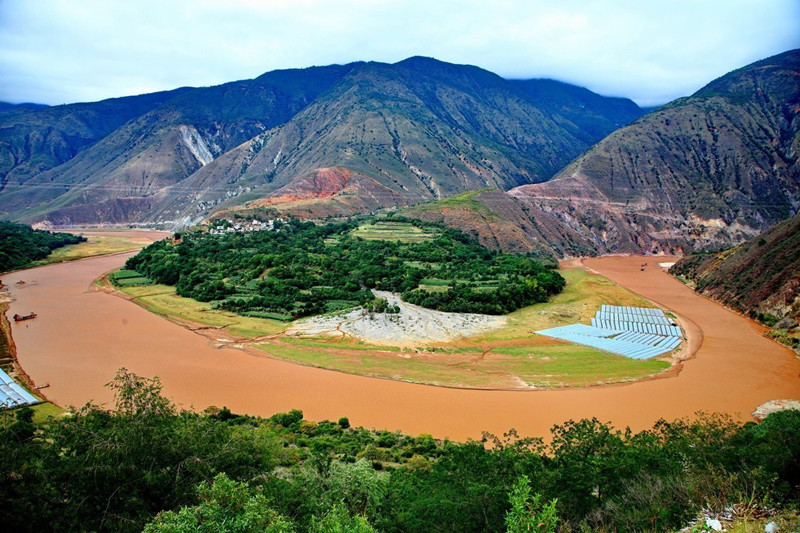Honghe River Valley in Yunnan
Overview
The Honghe River Valley (红河谷, Hónghé Gǔ) is a remarkable geographic feature located within Honghe Prefecture (红河州, Hónghé Zhōu) in Yunnan Province (云南, Yúnnán), China. Known for its vibrant red-hued waters, the valley is named after the Honghe River (红河, Hónghé), which flows through it and has two primary tributaries: the Yuanjiang (元江, Yuánjiāng) and the Lixian River (李仙江, Lǐxiānjiāng).
The Red River, also known as the Hong River (traditional Chinese: 紅河; simplified Chinese: 红河; pinyin: Hóng Hé; Vietnamese: Sông Hồng; Chữ Nôm: 瀧紅; Chữ Hán: 紅河), the Hồng Hà and Sông Cái (lit. “Mother River”) in Vietnamese,[citation needed] and the Yuan River (元江, Yuán Jiāng Nguyên Giang) in Chinese, is a 1,149-kilometer (714 mi)-long river that flows from Yunnan in Southwest China through northern Vietnam to the Gulf of Tonkin. According to C. Michael Hogan, the associated Red River Fault was instrumental in forming the entire South China Sea at least as early as 37 million years before present. The name red and southern position in China are associated in traditional cardinal directions.
Geographic Features
- Location: The valley spans across Honghe Prefecture in Yunnan, primarily in the southeastern part of the province.
- River System: The Honghe River is significant as a cross-border waterway, flowing from Yunnan into northern Vietnam.
- Dimensions: The river stretches approximately 1,280 kilometers, with around 695 kilometers of its length situated in China, while the remaining 585 kilometers flow through Vietnam.
Scenic Highlights
Geological Characteristics
The valley is characterized by unique geological formations, primarily red sandstone and shale, which are rich in iron oxide. These formations contribute to the river’s striking red appearance. The surrounding landscape features dramatic cliffs and lush valleys, providing stunning vistas for visitors.
Biodiversity
The region around the Honghe River Valley is known for its diverse ecosystems. Various species of flora and fauna thrive here, including rare and endemic species. The interplay of altitude, climate, and geography creates unique habitats, making it a hotspot for biodiversity.
Cultural Significance
The Honghe River Valley is home to several ethnic minority groups, including the Hani (哈尼, Hānī), Yi (彝族, Yízú), and Zhuang (壮族, Zhuàngzú). Each group brings its own cultural traditions, festivals, and customs, contributing to the rich tapestry of life in the valley. Traditional agriculture and handicrafts are still practiced, and local festivals often celebrate the river and its resources.
Economic Importance
The Honghe River serves as a vital resource for irrigation, supporting agriculture in the region. The fertile plains along the river are ideal for growing rice, corn, and various fruits. Additionally, the river is crucial for transportation, facilitating trade and movement between different communities.
Activities and Attractions
- Scenic Tours: Boat tours along the river offer breathtaking views of the landscape and opportunities to observe local wildlife.
- Hiking: Numerous trails wind through the valley, providing options for both casual walks and more challenging hikes.
- Cultural Experiences: Visitors can participate in local festivals, explore traditional villages, and taste authentic ethnic cuisines.
- Photography: The unique geological formations and vibrant colors of the valley make it a perfect location for photography enthusiasts.
Travel Information
How to Get There
- By Air: The closest major airport is in Kunming (昆明, Kūnmíng). From there, travelers can take a bus or drive to reach the Honghe River Valley.
- By Train: High-speed trains connect Kunming to cities in Honghe Prefecture like Chuxiong (楚雄, Chǔxióng) and Yuxi (玉溪, Yùxī).
- By Car: Renting a car provides the flexibility to explore the valley and nearby attractions at your own pace.
Travel Tips
- Best Time to Visit: The best months for visiting are April to June and September to November, when the weather is pleasant.
- Local Cuisine: Try local dishes such as Hani rice and Yi-style grilled meats for an authentic culinary experience.
- Respect Local Customs: Be respectful of the local cultures and traditions, especially when visiting ethnic villages.
- Guided Tours: Consider hiring a local guide to enrich your understanding of the area’s ecology and culture.

Location:













